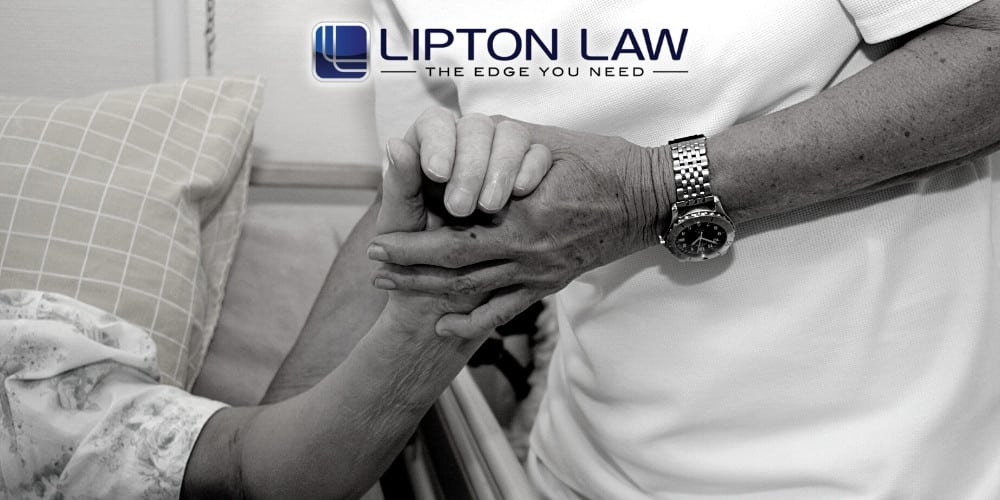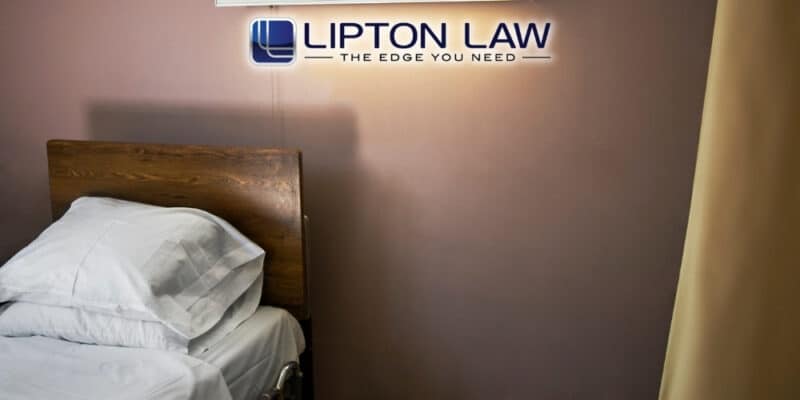Michigan Bedsore Lawyer

Nursing home occupants face a range of health hazards. For these vulnerable individuals, inadequate care can be permanently harmful. Bedsores and pressure sores may be different from other more obvious forms of mistreatment, but they’re no less serious. If your loved one has suffered the pain of bedsores, you need a qualified bedsore lawyer to fight for just compensation.
Why do the attorneys at Lipton Law care so much? Over the years, we’ve grown to love our place in the close-knit Southfield community. As one of Michigan’s premier sources of legal aid, we believe it’s our duty to provide honest and skilled counsel to nursing home abuse and neglect victims and their families.
What Is a Bedsore?
According to the National Institutes of Health, a bedsore is “damage to an area of the skin caused by constant pressure on the area for a long time.” Bedsores can damage both the skin and the underlying soft tissues, depending on the stage. The most common areas to see bedsores are bonier parts of the body. Bed sores tend to develop over long periods of time, from hours to days. While most of these wounds heal with proper treatment, some of them never completely heal.
Other terms for bed sores include pressure ulcers, pressure wounds, and decubitus ulcers.
How to Diagnose Pressure Ulcers

The best way to diagnose a pressure sore is to physically examine the area. A doctor will first examine the skin to determine if the patient has a pressure ulcer. If they do, the doctor will then assign a stage to the ulcer. Staging is important because it helps determine what treatment plan will best help the patient. Sometimes, in particularly serious cases, the doctor might order a blood test to assess the patient’s general health.
Symptoms of Bed Sores and Pressure Sores
The warning signs of developing bedsores are fairly easy to recognize. Below, we list the most common symptoms of bed sores.
- Swelling
- Significant and unusual changes in skin texture and color
- Skin that feels warmer or colder than normal
- Areas of tenderness
- Pus drainage from the area
Keep in mind that the symptoms of bed sores tend to vary depending on their stages. The higher the stage, the more skin breakdown and tissue damage the patient could suffer.
What Does a Bedsore Feel Like?
Again, the sensations that bedsores produce vary depending on their stage. Below, we outline how each stage of bedsores might feel.
- Stage 1: Feelings of pain, tenderness, itching, or burning. The skin might also feel softer or firmer than the surrounding tissue, as well as warmer or colder. If you press on the area and it doesn’t turn a lighter color, this is a good indication of poor blood flow to the area.
- Stage 2: In this stage, the skin is broken. The area will be red, warm, and swollen, likely with pus oozing out. This is very painful. Essentially, it looks and feels like a large, deep blister.
- Stage 3: The pressure ulcer has progressed into the fat tissue beneath the skin. You will likely smell an odor with other clear signs of infection. Sometimes there is tissue death, which looks black or very dark in color. Again, this is highly painful.
- Stage 4: The bed sore has progressed even deeper into the soft tissue beneath the skin. The signs of infection are even more significant, and the pain can be unbearable.
Bed Sore Statistics in Nursing Homes
According to the United States Department of Health and Human Services, nearly 100,000 nursing home residents suffer from at least one pressure ulcer each year. Bed sores are, unfortunately, one of the most common injuries that patients suffer in medical facilities, nursing homes, and long-term care facilities. They are also among the most costly.
Bed sores are supposed to be “never events” for nursing homes. Never events are clearly recognizable and avoidable injuries or medical errors that indicate problems with the safety of a nursing home facility. In other words, pressure injuries should never happen to nursing home patients. Unfortunately, they are often the result of nursing home neglect, which is an ongoing problem in the United States.
How to Prevent Pressure Ulcers in Nursing Homes
Those with medical conditions that require them to stay in bed for prolonged periods face high risks of developing pressure ulcers. Additionally, those who are confined to wheelchairs are also at a high risk of pressure sores. These ulcers can form when soft tissues sustain prolonged force, pressure, friction, or shearing.
Bedsores and other pressure ulcers can be prevented in an assisted living facility in the following ways.
- Rotate patients regularly to stop pressure buildup, approximately once every hour, ideally
- Keep the elevation of a bed to no more than 30 degrees
- Provide appropriate nutrition
- Keep surfaces clean
- Protect the skin’s health by moisturizing it regularly
- Frequently inspect residents’ skin to ensure that no bedsores develop
- Keep skin clean and ensure that it is completely dry
- Provide more accommodating sleeping surfaces and wheelchairs
What Are the Stages of Bedsores?
Medical care professionals categorize pressure sores based on their severity. There are four main stages of pressure sores, from stage 1 to stage 4. Stage 1 is the least severe, while stage 4 is the most severe. When nursing homes fail to prevent bed sores, it is important to understand how to administer the proper care. Staging a bed sore allows doctors to develop a treatment plan and give family members an idea of how long the recovery period might be.
What Is a Stage 1 Bedsore?

Stage 1 involves redness but no breaks in the patient’s skin. Generally, a stage 1 bedsore will fully heal in a few days after doctors relieve pressure points.
What Is a Stage 2 Bedsore?
Stage 2 is the most common bedsore stage in hospital patients and assisted living facilities. A nursing home resident with a stage 2 bed sore will likely experience pain, blistering, and breaks in the skin. They can also look like shallow craters. Medical professionals estimate that stage 2 bedsores may take up to 6 weeks to fully heal.
What Is a Stage 3 Bedsore?
Stage 3 involves deep cratering of the lesion, as well as a noticeable loss in tissue. Some of the tissue may begin to die. The underlying tissue begins to suffer damage, rather than just the skin. Because of the poor circulation and blood flow to the area for a prolonged period, the pressure injury is severe. It can take upwards of six months for nursing home or hospital-acquired bedsores to fully heal.
What Is a Stage 4 Bedsore?
Stage 4 is the most severe. Nursing home residents who develop bedsores at this stage will experience damage to the muscles, ligaments, skin, bones, and other soft tissues. At this stage, there is a much higher risk of serious infection. Treatment may last much longer than six months. Many nursing home residents who have bedsores at this stage require limb amputation.
Stage 4 Bedsore Life Expectancy
Only with proper treatment is the life expectancy for a stage 4 bedsore relatively high. Once bedridden patients reach stage 4, there is an estimated 50-day average life expectancy. If the assisted living facility staff can begin treatment as soon as possible, the risk of developing complications from the bedsores decreases.
Complications that can result from pressure ulcer development include the following.
- Sepsis
- Skin cancer (squamous cell carcinoma)
- Meningitis
- Cellulitis
Unstageable Bedsores and Deep Tissue Injuries
Two newer classifications of bedsores have become more common in recent years. These classifications are “unstageable bed sores” and “suspected deep tissue injuries.”
Unstageable pressure wounds are difficult to assign a stage to. This is because the very bottom of the wound is covered by pus, dead tissue, or other tissues. Doctors assign this label to pressure ulcers when they need to clean the wound in order to determine its depth.
Suspected deep tissue injuries are identified by their purplish or maroonish color. Discolored skin that is still unbroken or blisters filled with blood can indicate damage to the underlying soft tissue.
Common Locations of Pressure Ulcers

The most common locations on the body that have an increased risk for developing pressure ulcers differ depending on the limited mobility of each resident.
For residents confined to wheelchairs, bedsores are common in the following areas.
- The buttocks or tailbone area
- Spine and shoulder blades
- The backs of the legs and arms
For residents who are bedridden, bedsores are more common in the following areas.
- Hips, lower back, and tailbone
- Sides of the head or the back of the head
- Shoulder blades and spine
- Ankles, heels, and the backs of the knees
How Do Bed Sores Happen in Nursing Homes?
Nursing home neglect and nursing home abuse are the main causes of pressure sores. Elderly adults are at a greater risk of bedsores, as it is more difficult for them to change positions. After staying in the same position for too long, the lack of blood flow to the skin causes it to slowly decay. In an ideal situation, a nursing home will take all possible precautions to prevent bedsores. However, nursing home staff members contribute to the development of pressure ulcers in the following ways.
- Failing to regularly move or reposition residents.
- Failing to provide adequate food and water leads to poor nutrition.
- When staff members fail to properly move residents, this can cause excess friction or shear, which can damage the skin.
Risk Factors for Pressure Ulcers
Limited mobility is the most significant risk factor for pressure ulcers. However, other important factors include the following.
- Poor nutrition and hydration: Without the right vitamins, minerals, and nutrients, the skin becomes unhealthy. The longer the skin goes without proper nutrition, the more fragile it becomes.
- Too much or too little moisture: In order to stay healthy, the skin must be properly moisturized. However, too much moisture can also harm the skin. Moisture increases friction. Keeping the skin both clean and dry is important to lower the levels of friction.
- Poor sensitivity: Some residents have spinal cord injuries or nervous system conditions that affect their skin sensitivity. Without the ability to feel pain as well, residents might not be able to communicate about pressure ulcers.
- Existing medical conditions: Certain conditions such as diabetes contribute to limited blood flow in the body. This makes pressure ulcer prevention even more essential.
How Does Nutrition Affect Bed Sores?
Not only is proper nutrition essential to the prevention of bedsores, but it is also essential for wound healing when a bed sore does occur. In fact, residents with bedsores actually require extra nutritional intake than those without. Extra protein, vitamins, and minerals aid in the healing process. Malnourishment can greatly lengthen the healing process.
Can Bed Sores Lead to Death?

Yes. It is possible for a pressure ulcer to lead to the wrongful death of a nursing home resident. Pressure sores are basically open wounds that welcome bacteria and infections. Without timely treatment, an infection can turn into sepsis, which can turn into septic shock. Septic shock is extremely difficult for even a relatively healthy person to recover from. Elderly patients who go into septic shock are more likely to experience organ failure and even death. If this happens, family members of the deceased should file a wrongful death lawsuit against the responsible parties. Allowing pressure ulcers to progress to the point of death is a clear indicator of medical malpractice.
What Should I Do if My Family Member Developed Bedsores?
First, seek immediate medical attention for your loved one. The longer you wait to get treatment, the worse the situation becomes. After they receive the care they need, we recommend contacting the bed sore lawyers at Lipton Law. We will help you gather information and evidence about your nursing home bedsore case and file a complaint to the local ombudsman.
State health departments and ombudsmen are highly trained and qualified to fully investigate complaints and cases of medical negligence. Working with an experienced attorney can help you protect yourself and fight for compensation for both your family and your injured loved one.
What Are My Legal Rights If My Loved One Has Pressure Sores or Bedsores?
At Lipton Law, our elder abuse attorneys are known for investigating cases with unfailing thoroughness. We will help you research the legal options based on your circumstances, collect evidence such as wound photos and care records, and call expert witnesses who can help you state your case more clearly. You have every right to file a lawsuit on behalf of your elderly loved one. Nursing home abuse is unacceptable, and we will help you fight for justice.
We devote our full attention to helping our clients establish strong claims that hold negligent nursing homes accountable. It is our goal to prevent other elderly nursing home residents from suffering as your loved one did.
How to File a Nursing Home Bedsore Lawsuit

In order to file a bed sore claim, we recommend speaking with a qualified law firm that has handled bedsore claims in the past. At Lipton Law, we offer a free consultation for our clients. During this consultation, we evaluate the facts of your case and determine whether or not you have the grounds for a lawsuit.
The compassionate and qualified attorneys at Lipton Law will outline all of your legal options. Before we file the lawsuit, we will gather as much evidence as possible. Examples of this evidence include relevant medical records, pictures, videos, and documented signs of nursing home abuse. Once we have a strong case, we will file the lawsuit on your behalf and begin the litigation process.
How Much Can You Sue for Bed Sores?
When your elderly loved one suffers from pressure ulcers, your family likely has mounting medical expenses related to the treatment of those injuries. This can place a heavy financial burden on any family. When you file a bed sore lawsuit, you could receive compensation for the following losses.
- Current and future medical expenses
- Pain and suffering
- Disability
- Permanent disfigurement
File a Nursing Home Bedsore Lawsuit Today
After your loved one experiences an injury in a nursing home, the last thing you want to do is put them through further pain and suffering. Planning ahead can reduce the amount of time you spend in court, lower your legal costs, and make life easier for your loved one. You can rely on us to identify the most effective approach to handling your legal matter.
Contact the qualified law firm of Lipton Law to ensure that you can effectively fight for justice for your family. Our nursing home abuse lawyers will fight tooth and nail to right the wrongs that you and your loved ones have endured. Call 248-557-1688 to schedule your free consultation with us. Remember that any confidential or sensitive information that you share with us will remain confidential.
Types of Nursing Home Abuse
Practice Areas

